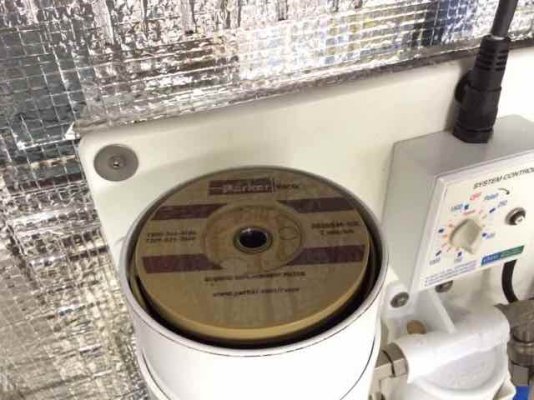psneeld
Guru
Does An Empty Tank Condensate? Photo Gallery by Compass Marine How To at pbase.com
It is not that sjmple.....
It is not that sjmple.....
Fuel polishing is just the newest income enhancing product for those that make and sell the systems. .
His opinion was the the fuel had degraded because I stored it for months as we don't cruise as often as we should. Suggested we use the boat,burn and circulate and clean the fuel,or store less and polish it every 6 months or so. Made a polishing system and have much less fuel 100 gallons ves350 in each tank. Both welder and fuel supplier said that over time the toxicity in the bottom of the tank will degrade the welds and aluminium if it finds a weak weld or section. Hope pics show this.
Our tanks are 200 each. If the tank is full the fuel has been turned 1.5 times. If the tank is half full the fuel has been turned 3 times in a day’s run. For each tank, the fuel is filtered about 30 times before it is burned. ( Anyone remember their calculus and can calculate this?)
Two things. First, half who read this post are the choir and the other half add premium fuel the their regular rated vehicle. The second half are not hurting anything and are driving the economy.
Second, if where you buy boat fuel does not have an in line spin on filter near the hose outlet - buy elsewhere. Refiners and haulers are regularly checked for fuel quality, not so the dock supply tanks.
Fill once a year. Fuel polish when we move fuel from tank to tank. New fuel goes into the aft tanks and is polished when it is moved to the front tanks. Fuel for the port tank is moved to the starboard tank to trim the boat. The engine draws and returns to the starboard tank.
If you polish and return to the same 100 gallon tank, the half life theory means you have only polished 50% of the tank when you have polished 100 gallons. If you repeat the process and move 100 gallons through the system again, you will have polished 75% of the fuel. So it is more efficient if you can move fuel from a full tank to an empty tank.
The PO put an expensive ESI system on the boat, as well as new fuel tanks. Personally, I think it's overkill, but I have it so I use it.
Jim
Sent from my iPad using Trawler Forum


Fuel polishing is merely fuel filtering.
Polishing: the removal of water, sediment, non-combustible particulate matter and microbial contamination below levels stated in ASTM D975 (Standard Specification for Diesel Fuel Oils) while resuspending combustible particulate matter to maintain ASTM standards for BTU value, lubricity, and cetane. [/INDENT][/I]
I'm only reporting my observations. Personally, I wouldn't install a fuel polishing system based on my experience. But I have one and I use it to move fuel around. I fill once a year, 500-600 gallons.
Jim
Sent from my iPad using Trawler Forum
ESI has been around over 15 years and claims no fuel failures in that time. They call their system a total fuel management system. They also do things like emergency fuel delivery and delivered after Katrina when fuel was a major problem. They're also big in supplying critical industry that must be fail-safe.
There's a very good discussion of their system here:
ESI Fuel-Polishing System
That article also explains the difference between their polishing system and filtering systems.
I've never used their system but a lot of ocean crossing vessels do.

J
I'm sorry but I'm afraid I have to call BS on that article.
The system pictured in it is nothing more than a Racor filter, a pump (most likely a gear pump) a timer and a magnet of very dubious usefulness.
It is in no way special.
"Moreover, the unit has a high-flow continuous-duty pump that is tweaked to optimally agitate contaminates in the boat’s fuel tanks during the system’s operation, thereby facilitating total, as opposed to partial, processing."
Now that is first class marketing BS right there.
The pump is "tweaked" to "optimally agitate " the fuel in the tank !? Yeah, right!
We do use Alfa Laval which has a centrifuge.

